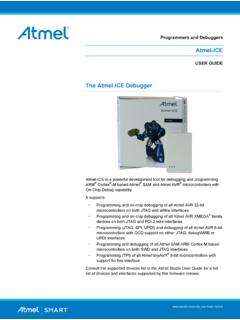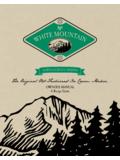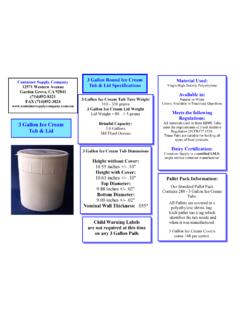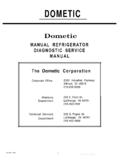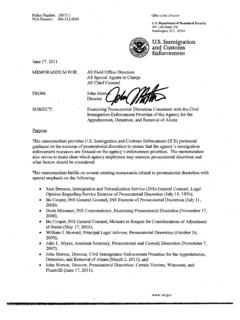Transcription of ONCE-THROUGH WATER-COOLED REFRIGERATION, …
1 ONCE-THROUGH WATER-COOLED REFRIGERATION, ICE-MAKING AND AIR CONDITIONINGNew York City restaurants, groceries, food stores and other similar establishments that store and prepare food may have cold boxes, ice-makers, beer and soda cases, freezers and other equipment that is cooled by City wa-ter. This type of machinery consumes large volumes of water that flows ONCE-THROUGH , and is then disposed of into the sewer, resulting in higher than necessary water and sewer bills for food-related businesses. When the equipment is properly maintained it can use between 100 and 1,000 gallons of water daily. Unfortunately, ONCE-THROUGH WATER-COOLED equipment is often not well-main-tained and consumes more water (and electricity) than required for the cooling Does This Mean for My Water/Sewer Bills?
2 Even when properly maintained, the relatively small beer and soda cases located in small food stores throughout the City use several hundred gallons of water a day. Ba-sic maintenance can avoid unnecessary water use. The table also illustrates the benefit of basic maintenance, such as insulating the water pipes to the WATER-COOLED equipment, particularly if the pipes run through warm Importance of MaintenanceThe flow of ONCE-THROUGH cooling water is usually controlled by a small valve, called a solenoid. When the refrigeration or air-conditioning compressor turns on, the valve opens to allow water to cool the com-pressor. When the compressor cycles off, the sole-noid valve should close, ending the flow of cooling water until it is needed again.
3 The largest problem occurs when the solenoid control valve fails, usually when in an open position. This means that water continues to flow through the equipment 24-hours a day. When this occurs, the equipment can use (and waste) thousands of gallons of water. In almost every case where a food-related business contacts the New York City Department of Environmental Protection (DEP) about high water and sewer costs, WATER-COOLED equipment, and usually a failed solenoid con-trol valve, are the primary Water TemperatureDaily Cooling Water UseAnnual Water/Sewer CostAnnual Electricity Cost at 12 /kwh50 F500 Gallons$1,647$2,060/Year70 F1,000 Gallons$3,294$2,370/Year90 F2,000 Gallons$6,589$2,680/YearWater and Energy ConsumptionIncreases with High Water TemperatureA standard 800 pound per day ice machine uses 500 gallons of cooling water per day plus the water for the ice costing about $2,000 per year in water/sewer costs in addition to another $2,000 per year in electricity can often tell if the control valve has failed.
4 By reach-ing down the drain where the used cooling water flows to the sewer. Look for a small hole in the floor to the side or behind the refrigeration equipment with a pipe leading to, but not connected to, another pipe. If you see water flowing , test the temperature with your fingers. If the water is warm, the compressor is working and the cool-ing water is doing its job. If it s cool, the cooling water flowing to the sewer is , ice-making and air-conditioning equipment which use ONCE-THROUGH cooling water should have maintenance checks at least once a Maintenance Tips1. Make sure the control valve s function is checked at least annually. 2.
5 Keep walk-in freezer or cooler doors closed. Avoid propping them Insulate cold water piping leading to WATER-COOLED equipment, particularly if it is located in a warm Make sure that interior lights in walk-in freezers or coolers are turned off when no one is inside. A single 100-watt light bulb left on for ten hours a day, five days a week will add as much additional cooling requirement as would be provided by a large window air Keep the exposed cooling coils clean and free of Make sure all seals on refrigeration case doors and cases are in good condition. They protect cold air from leaking out of equipment in the same way weather stripping on windows keeps cold air Install plastic inner door strips in walk-in coolers and freezers to seal in cold StandardsNew York City s Administrative Code prohibits new instal-lations of ONCE-THROUGH WATER-COOLED equipment except ice-making machines producing less than 500 pounds of ice per day.
6 Existing equipment can remain in place but for many years has been limited to six (6) tons of refrigeration or two (2) tons of air conditioning. USEPA s EnergyStar program has voluntary efficiency standards for ice makers and the Consortium for Energy Efficiency lists models by level of energy and water NYSERDA The New York State Energy Research and Development Authority and 1-877-NY-SMART (1-877-697-6278) CEE Consortium for Energy Efficiency and (617) 589-3949 WaterWiser Information Clearinghouse: AWWA American Water Works Association EnergyStar Green Hotel Certification (NYS DEC) Green Restaurant Association.
7 Additional information visit the DEP website at For all City non-emergency government information and services, dial 311 Discharge PipeSewerDrainOnce-throughwater cooledequipmentFloorBill de Blasio, MayorEmily Lloyd, CommissionerPrinted on recycled paper 07/14 New York City Department of Environmental Protection, 59-17 Junction Boulevard, Flushing, NY 11373










